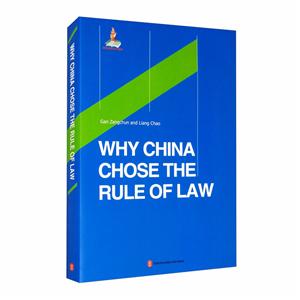-
>
佟柔中国民法讲稿-签名本
-
>
中华人民共和国建筑法
-
>
当代德国法学名著德国强制执行法(下册)(当代德国法学名著)
-
>
中华人民共和国刑法注释本(根据刑法修正案(十一)全新修订)
-
>
中华人民共和国民法典(含司法解释)(大字版)
-
>
中华人民共和国刑法(含刑法修正案(十一)及法律解释)
-
>
洞穴奇案
法治的中国道路(英文版) 版权信息
- ISBN:9787119118154
- 条形码:9787119118154 ; 978-7-119-11815-4
- 装帧:一般胶版纸
- 册数:暂无
- 重量:暂无
- 所属分类:>
法治的中国道路(英文版) 内容简介
本项目既是对十八届四中全会精神的精要解读,同时也是对“依法治国”主题的一种深刻阐释。本书尝试从回答靠前社会和靠前读者关切的问题入手,在调查研究的基础上,以大量事例、详实数据和平实鲜活的语言,对中国的法治传统、法治观念、法治模式以及法治建设情况进行了系统介绍。本书以上下两篇共十四个章节,详细论述和阐释了“中国共产党的法治观”,“中国的权利约束机制”、“法治与依法执政”、“法治与司法改革”、“法治与法治社会”、“中国的人权理念和实践”等十几个方面的关键问题。这既是对未来中国法治国家建设路线图的详细描述,也是对新一届中央领导集体的执政理念和治国方略的宣传阐释,同时也将填补我法治建设对外宣传的空白,推动中国政治话语体系的建设。
法治的中国道路(英文版) 目录
Chapter Ⅰ Why Did Modern Rule of Law Not Emerge in China First?
Section Ⅰ China Already Had the Social Gene for Modern Rule of Law in the Late Ming and Early Qing Period
Section Ⅱ The Powerful Feudal Autocracy and the Perfected
Governance System Killed Modern Rule of Law at Birth
Section Ⅲ Natural. Economy and the Policy of "Emphasizing Agriculture,
Restraining Commerce" Suppressed the Growth of Capitalism
Chapter Ⅱ How Did Rule of Law Begin in China?
Section ⅠThe Historic Context of Western Legal Culture's Introduction to China
Section Ⅱ Different Traditions of Legal Culture in China and the West
Section Ⅲ Rule of Law Embraced Socialism in China
Chapter Ⅲ Why Did China Choose Rule of Law?
Section Ⅰ Debate over Rule of Law and Rule of Man After 1949
Section Ⅱ Basic Motivations Behind the Party's Choice of Rule of Law
Section Ⅲ Major Arrangements for the Path to Socialist
Rule of Law with Chinese Characteristics
Section Ⅳ Key Factors Determining Success or Failure of Rule of Law in China
Section Ⅴ Criteria for Measuring the Success of Building Rule of Law
Chapter Ⅳ How Does China's Path to Rule of Law Differ from the West's?
Section Ⅰ What Is the Relationship Between Leadership by the Party and Rule of Law?
Section Ⅱ The CPC's View on Fairness and Justice
Section Ⅲ The CPC's View on Power
Section Ⅳ How Concepts of Human Rights Differ Between China and the West
Afterword China's Path of Rule of Law in the Period of Social Transformation
法治的中国道路(英文版) 节选
In medieval Europe, central government had weak control over local governments, a situation that laid the important foundation for constraining sovereign power and implementing modern rule of law.States, manors, and cities commonly enjoyed autonomy.The jurisdic-tion of kings, lords, heads of civil councils and other local officials was an inherent authority rather than one granted by the emperor.Although local power could not compare with sovereign power, it was independent of the latter and a tendency toward the decentralization and diversifi-cation of power.Such a relationship between central and local govern-ments led to a particular Western tradition of a pluralist legal system including state laws, feudal laws, manor laws, city laws and business laws, in which legalinstitutions and judiciaries were not monopolized by central government.Of these, feudallaw regulated the rights-obligations relationsFup between feudal lords and vassals; manor laws regulated the relationship between lords and peasants and agricultural production;city law was a system of laws determined by citizens to ensure city autonomy and order; business law regulated domestic and international trade as well as maritime commerce.These sets of laws were the result of two sides being in agreement, rather than the stronger side imposing its will.Although the emperor was the most powerful lord, the relation-ship between emperor and kings, kings and vassals, central government and cities was not a relationship of one-way dorrunance and submis-sion, but a contractual relationship predicated on mutual benefits,a relationship containing stable rights and obligations.This unique legal tradition restricted the power and status of the monarch by means of laws and contracts, making it possible to establish modern rule of law with its emphasis on "restriction on public power and assurance of hu-man rights" and its removal of absolute power from the emperor and kings. In China, the traditional central-local government relationship was completely different.With the abolition of the enfeoffment system and the establishment of prefectures and counties by Qin Shi Huang (259-210 B.C.),the first emperor of the Qin, things changed-the enfeoffment system only maintained lordship status symbolically, and there was an increasing trend toward unification; centralized authotity expanded so widely that the em-peror gradually deepened his control over the local governments' jurisdic-tion over property, personnel, military power and judiciary.For example,the selection, appointment and removal of local officials were decided centrally via the imperial examination system; by appointing finanaal offi-cials at the local level and conducting vert:ical management, local financial resources were turned over to the center; by minimizing local govern-ments' power of military deployment, authority to mobilize troops rested chiefly with the central government; establishing a centraLized legislation system where the central government had virtually all legislative power while the local governments had none; making the emperor the supreme judge, able to change judiaal decisions at will. ……
- >
新文学天穹两巨星--鲁迅与胡适/红烛学术丛书(红烛学术丛书)
新文学天穹两巨星--鲁迅与胡适/红烛学术丛书(红烛学术丛书)
¥9.9¥23.0 - >
名家带你读鲁迅:故事新编
名家带你读鲁迅:故事新编
¥13.0¥26.0 - >
罗庸西南联大授课录
罗庸西南联大授课录
¥13.8¥32.0 - >
巴金-再思录
巴金-再思录
¥33.1¥46.0 - >
史学评论
史学评论
¥18.5¥42.0 - >
随园食单
随园食单
¥37.0¥48.0 - >
龙榆生:词曲概论/大家小书
龙榆生:词曲概论/大家小书
¥9.1¥24.0 - >
企鹅口袋书系列·伟大的思想20:论自然选择(英汉双语)
企鹅口袋书系列·伟大的思想20:论自然选择(英汉双语)
¥8.4¥14.0
-
国富论:“现代经济学之父”亚当·斯密的传世名作
¥11.4¥38 -
《人权宣言》在晚清中国的旅行
¥14.4¥45 -
1607-1788-边缘与中心-帝国宪制的延伸-大英帝国与美利坚合众国
¥27.3¥58 -
中国古代的法律
¥3.6¥12.5 -
唐代官吏职务犯罪研究
¥12¥28 -
“现代经济学之父”亚当.斯密的传世名作:国富论
¥18.4¥36



















